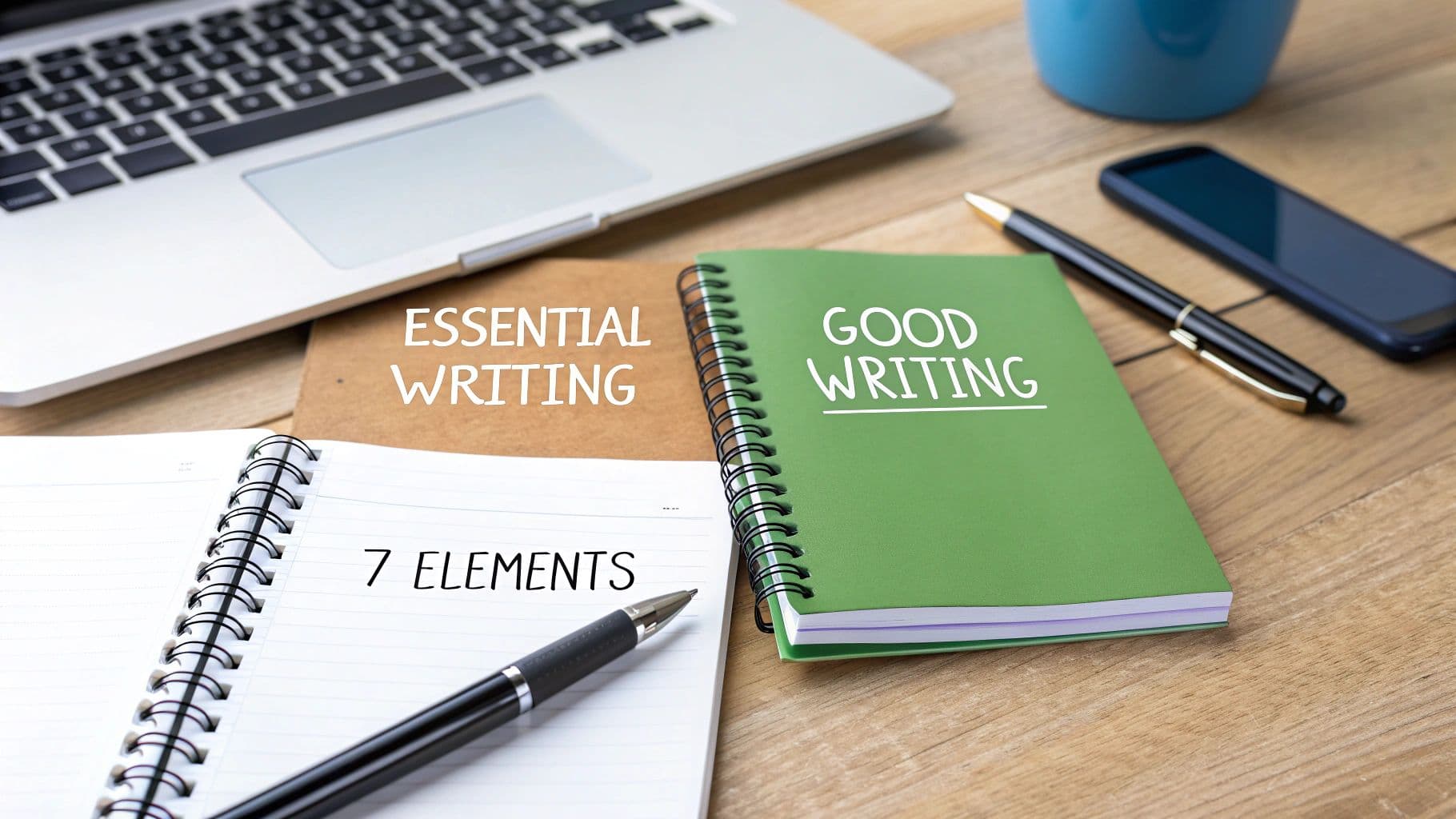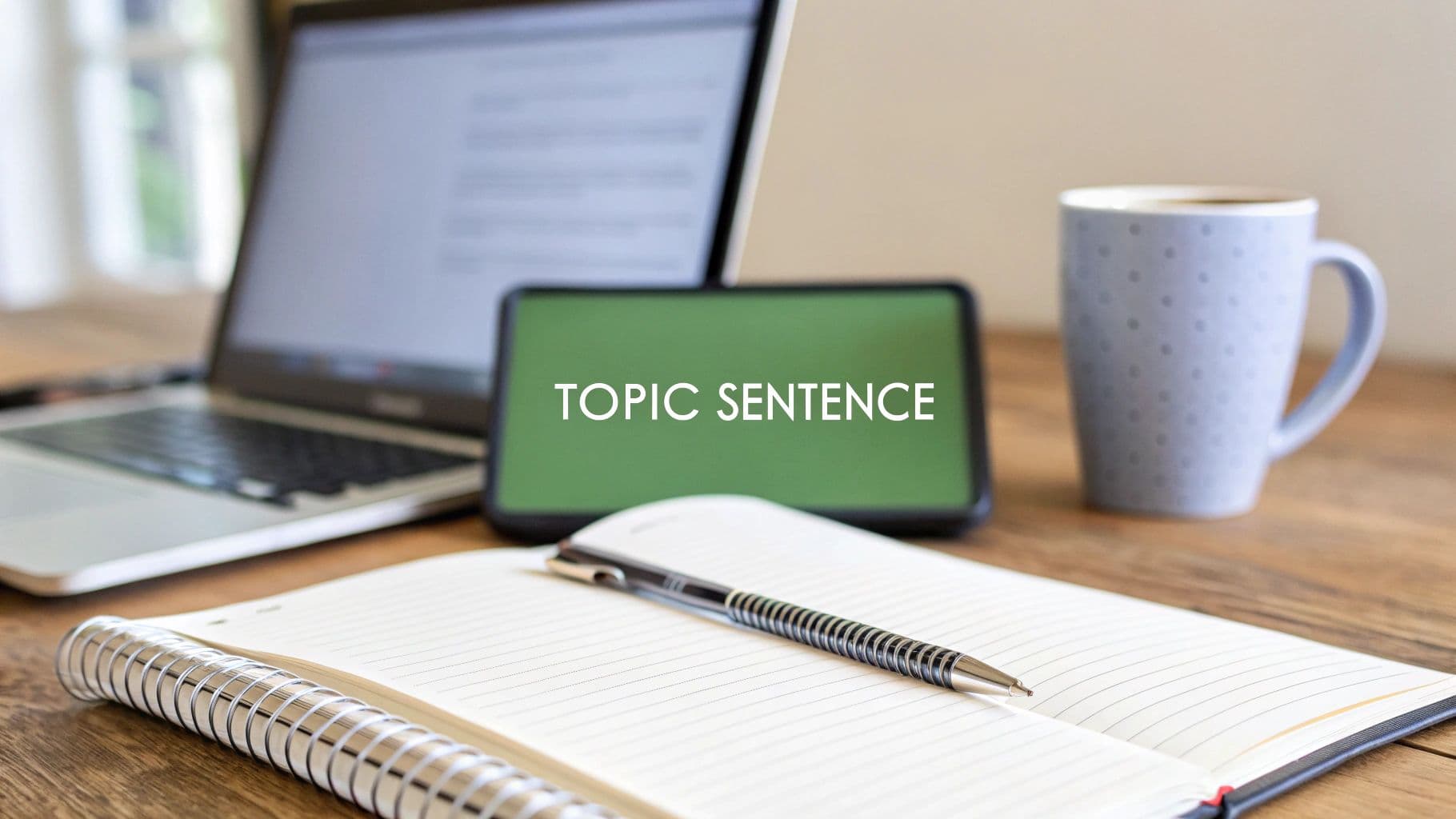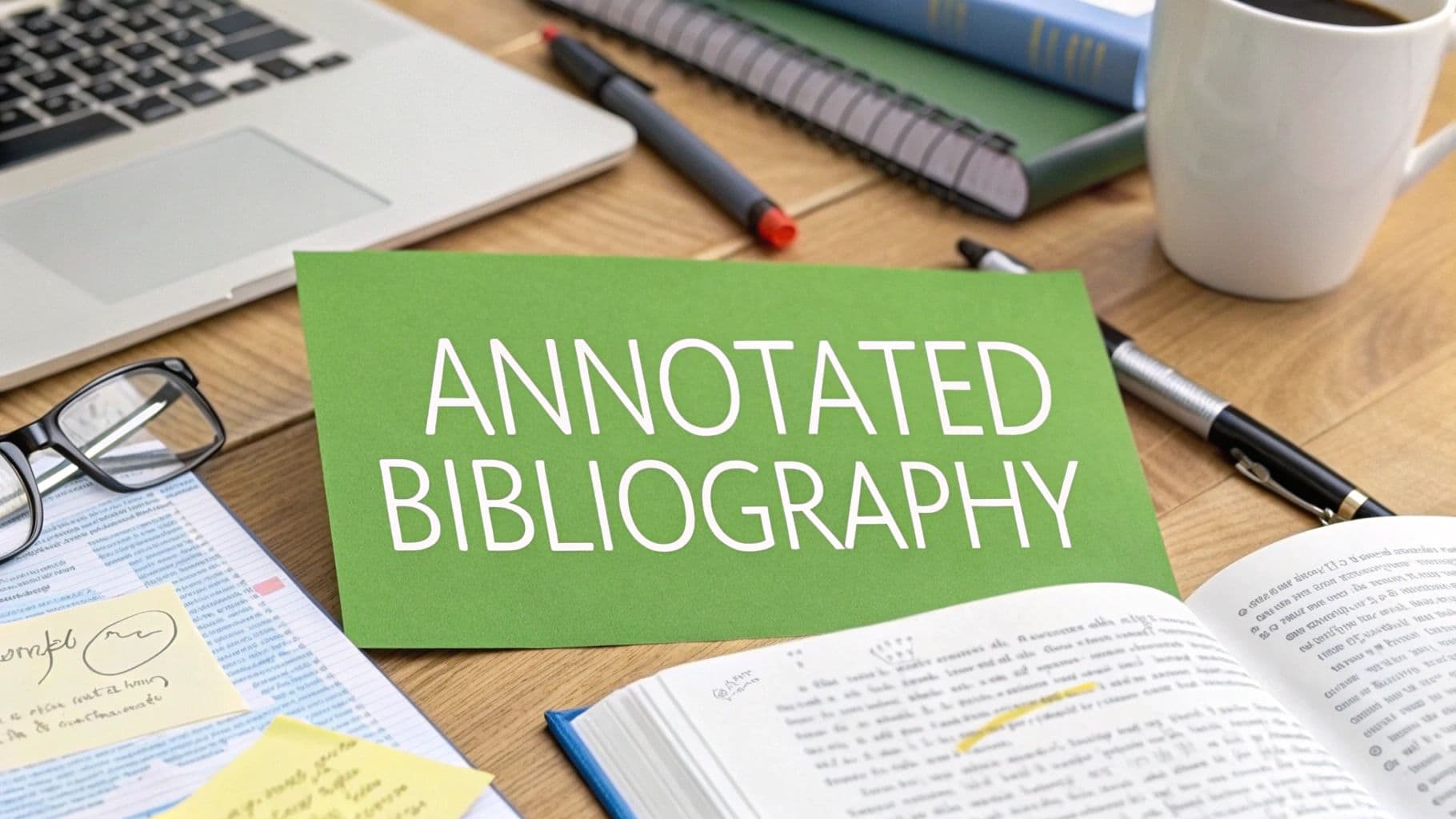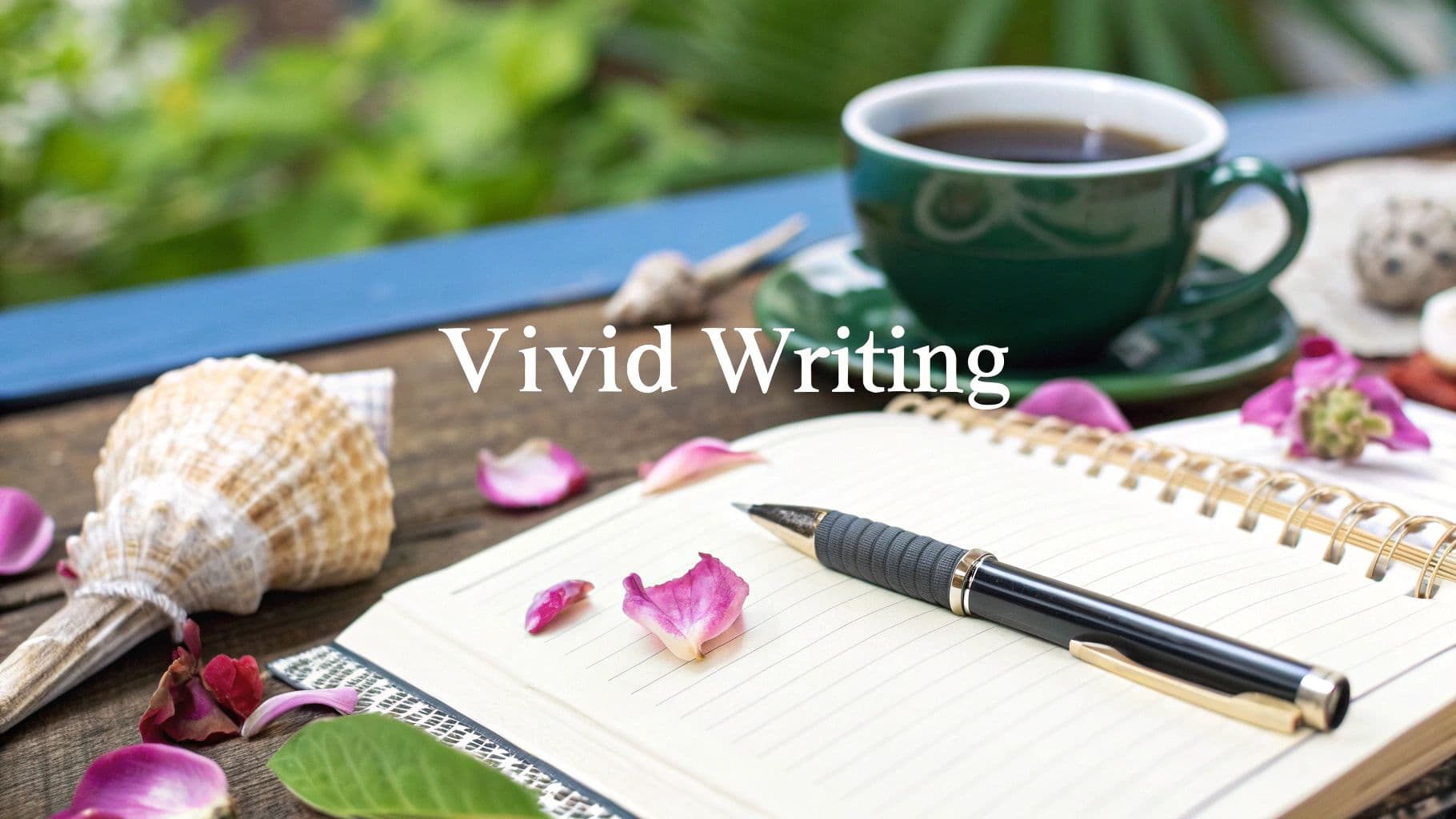
7 Essential Elements of Good Writing to Master in 2025
July 8, 2025
In a world saturated with content, the ability to write well is more than a skill; it's a superpower. But what truly separates mediocre text from masterful prose? The answer lies in mastering the fundamental elements of good writing. These core principles are the building blocks of communication that captivates, persuades, and informs, forming the DNA of every powerful message.
Whether you're a student refining an essay, a marketer crafting a campaign, or a professional drafting a critical email, understanding these elements is non-negotiable for making an impact. Generic advice falls short. True improvement comes from a deep, practical understanding of what makes sentences connect and ideas resonate with an audience. This comprehensive guide moves beyond the basics to deconstruct the essential components that elevate text from functional to unforgettable.
This listicle breaks down the seven most crucial elements of good writing, including:
- Clarity and Precision
- Strong Structure and Organization
- Compelling Voice and Tone
- Engaging Hooks and Openings
- Concrete Details and Evidence
- Rhythm and Flow
- Precise Word Choice and Vocabulary
For each component, you will find in-depth definitions, actionable strategies, and real-world examples. We'll also explore how modern tools like Natural Write can help you refine AI-generated drafts, ensuring your final piece is not just grammatically correct, but genuinely compelling and human-like. Prepare to transform your writing from simply adequate to truly exceptional.
1. Clarity and Precision
At the core of all effective communication lies clarity and precision. This foundational element of good writing involves conveying your message so directly and unambiguously that the reader understands your exact meaning without effort. It’s about stripping away vagueness, jargon, and unnecessary complexity to present your ideas in their most accessible form. When writing is clear and precise, it builds trust, prevents misunderstanding, and ensures your message has the intended impact.

This principle is championed by literary giants like Ernest Hemingway, whose minimalist prose delivered profound emotional weight, and George Orwell, who advocated for plain language in his essay "Politics and the English Language." The goal is simple: make your point, make it sharp, and leave no room for error.
Why It's a Crucial Element
Clarity isn’t just about being understood; it’s about respecting your reader's time and cognitive energy. Confusing, dense, or ambiguous text forces the reader to work harder, increasing the likelihood they will abandon your content. From a technical manual to a marketing email, precision ensures the correct action is taken or the intended feeling is evoked. It is the bedrock upon which all other elements of good writing are built.
Key Insight: "Good writing is like a windowpane." - George Orwell. This quote perfectly captures the essence of clarity. The goal is for the reader to see the idea through the words, not to get stuck looking at the words themselves.
Actionable Tips for Achieving Clarity
Implementing clarity and precision requires conscious effort and specific techniques. Here’s how you can immediately improve this aspect of your writing:
- Prioritize Active Voice: Active voice is more direct and energetic. Instead of "The ball was hit by the boy" (passive), write "The boy hit the ball" (active). This immediately makes sentences clearer and more concise.
- Choose Specific Nouns and Verbs: Vague words create fuzzy images. Replace general terms with specific ones. Instead of "The man went to the store for some things," write "John jogged to the corner market for milk and bread."
- Eliminate Redundancies: Phrases like "completely finished," "basic fundamentals," and "past history" contain redundant words. Pruning these "verbal weeds" tightens your prose.
- The "Unfamiliar Reader" Test: Ask someone who knows nothing about your topic to read your draft. Their questions will reveal exactly where your writing is unclear or assumes too much prior knowledge. This is one of the most effective ways to spot ambiguity.
- Simplify Your Vocabulary: Don't use a complex word when a simpler one will do. While a rich vocabulary is an asset, using words like "utilize" instead of "use" or "effectuate" instead of "cause" often adds unnecessary fluff. Clarity is not about dumbing down ideas; it's about expressing them brilliantly.
2. Strong Structure and Organization
Strong structure and organization provide the backbone of effective writing. This crucial element involves arranging ideas in a logical, coherent sequence that guides readers smoothly from introduction to conclusion. It acts as a roadmap, ensuring each paragraph and section serves a distinct purpose and contributes to the overall argument or narrative. When writing is well-structured, the reader can follow the flow of information effortlessly, making the content more persuasive, memorable, and impactful.

This principle has ancient roots, articulated by Aristotle in his classical rhetoric, and is just as vital today. Modern masters of structure like Malcolm Gladwell use it to weave complex ideas into compelling stories in books like The Tipping Point. A solid framework transforms a collection of disparate facts into a powerful, cohesive message, a cornerstone of the elements of good writing.
Why It's a Crucial Element
Without a clear structure, even the most brilliant ideas can get lost. A disorganized piece of writing forces the reader to connect the dots, which can lead to confusion, frustration, and abandonment of the text. From business reports that need to convey key findings quickly to academic papers that build a rigorous argument, organization is what makes information digestible and convincing. It builds credibility and shows respect for the reader's intellectual journey.
Key Insight: "Structure is the skeleton of a narrative. It's the invisible framework that supports the entire story." - Unknown. This analogy highlights how a strong internal structure, though not always visible, is essential for holding the entire piece together and giving it shape.
Actionable Tips for Achieving Strong Structure
Building a solid framework for your writing is a deliberate process. By adopting a few key habits, you can dramatically improve the organization and flow of your work.
- Create an Outline Before Writing: This is the single most effective way to ensure logical flow. Map out your main points, supporting evidence, and conclusion before you write a single paragraph. For complex projects, you can explore detailed guides on how to craft an effective research paper outline.
- Use Headings and Subheadings: Break your text into logical, labeled sections. Headings act as signposts, helping readers navigate your content, understand the hierarchy of information, and find what they need quickly.
- Employ Strong Transitional Phrases: Use words and phrases like "consequently," "in addition," "on the other hand," and "for example" to create smooth bridges between sentences, paragraphs, and sections. These transitions signal shifts in thought and clarify relationships between ideas.
- Follow the "Tell, Show, Tell" Principle: A classic communication structure: tell them what you're going to tell them (introduction), tell them (body), and then tell them what you told them (conclusion). This repetition reinforces your main message.
- Review Your Structure with Topic Sentences: Read only the first sentence of each paragraph. Do they form a coherent and logical summary of your argument? If the flow feels disjointed, your overall structure needs refinement.
3. Compelling Voice and Tone
If clarity is the brain of good writing, then voice and tone are its heart and personality. This crucial element infuses your words with character, making them feel human and relatable. Voice is the distinct, consistent personality of the writer coming through the text, while tone is the specific attitude or emotion conveyed toward the subject and the audience in a particular piece. Together, they create the unique 'sound' of your writing, forging a connection that makes your message more engaging, persuasive, and memorable.

This principle is mastered by writers like Joan Didion, whose introspective and precise tone creates a sense of profound observation, and Seth Godin, whose direct, motivational voice in his blog posts inspires action. Even brands leverage this, like Mailchimp, which uses a friendly and encouraging brand voice to make marketing technology feel approachable. A compelling voice and tone are what separate forgettable text from writing that resonates long after it's been read.
Why It's a Crucial Element
Voice and tone are what build relationships with readers. In a world saturated with content, a unique voice cuts through the noise and helps you stand out. It transforms your writing from a mere information delivery system into an experience, fostering loyalty and trust. Tone, when adjusted correctly for the context, ensures your message is received as intended, whether you aim to be authoritative, empathetic, humorous, or urgent. This is one of the most powerful elements of good writing for building a dedicated audience.
Key Insight: "Tone is the attitude the writer projects toward the subject and the reader. It is the writer's 'voice'." - William Strunk Jr. & E.B. White, The Elements of Style. This highlights that voice isn't just an abstract quality; it's a tangible attitude that the reader can feel and respond to.
Actionable Tips for Achieving a Compelling Voice and Tone
Developing a strong voice and mastering tone requires self-awareness and practice. Here are practical ways to cultivate this essential writing skill:
- Define Your Audience First: Before you can set a tone, you must know who you're talking to. A formal, academic tone is perfect for a research paper but would alienate an audience on a social media platform. Understanding your reader’s expectations is the first step.
- Read Your Work Aloud: This is the single best test for voice. Does it sound natural? Does it sound like you (or your brand)? Reading aloud helps you catch awkward phrasing and tonal shifts that your eyes might miss.
- Study Writers You Admire: Analyze the work of authors whose voice resonates with you. Break down their sentence structure, word choice, and rhythm. Don't copy them, but learn from their techniques to find your own authentic style.
- Be Authentic, Not an Imitator: Your most powerful voice is your own. Trying to mimic another writer often comes across as inauthentic. Draw from your unique perspective, experiences, and personality to create a voice that is genuinely yours.
- Adjust Tone for Context and Purpose: Your voice should remain consistent, but your tone must be flexible. The encouraging tone of a how-to guide will differ from the serious, respectful tone of a condolence message. For businesses, establishing clear brand voice guidelines is essential for maintaining consistency across all communications. Learn more about creating these standards by exploring these brand voice guidelines.
4. Engaging Hooks and Openings
Engaging hooks and openings are the critical first moments that capture a reader's attention and compel them to continue. In an age of information overload, a powerful opening acts as your first handshake, creating immediate interest, establishing the stakes, and promising value. It’s the difference between a piece of content being eagerly consumed or instantly dismissed. A strong opening is one of the most vital elements of good writing because if you can't get the reader past the first sentence, the rest of your words don't matter.

This principle is mastered by authors like Stephen King, who often begins with an unsettling or deeply personal line, and journalists at publications like Buzzfeed, whose curiosity-driven headlines are famously effective. From the iconic opening of Charles Dickens' A Tale of Two Cities to a modern TED Talk that starts with a shocking statistic, the goal is the same: grab the reader and don't let go.
Why It's a Crucial Element
Your opening sentences are the gateway to your entire message. Without a compelling hook, even the most brilliant and well-structured arguments will go unread. A strong opening sets the tone, frames the reader's expectations, and builds momentum that carries them through the rest of the text. Whether you're writing a blog post, an academic paper, or a marketing email, the hook is your single best chance to convince the reader that your content is worth their time and attention.
Key Insight: "The first sentence can’t be just a warm-up. It must, in some way, promise that the article will be worth reading." - Poynter Institute. This underscores the high-stakes nature of your opening line; it’s not throat-clearing, it’s a direct promise of value to the reader.
Actionable Tips for Crafting Engaging Hooks
Creating an irresistible opening requires a strategic approach. You can learn more about how to write compelling content on our blog. Here are some proven techniques to make your openings more powerful:
- Start with a Surprising Statistic or Fact: A shocking number or a little-known fact can immediately pique curiosity. For example: "The human brain generates about 12-25 watts of electricity, enough to power a low-wattage LED light."
- Use a Compelling Anecdote: A short, relevant story creates an instant human connection and makes abstract topics feel more tangible. Begin with a relatable scenario that illustrates the core problem you plan to solve.
- Ask a Thought-Provoking Question: A question directly engages the reader's mind, inviting them to participate in the conversation. Make it a question they feel compelled to answer, like "What if you could learn a new skill in half the time you thought possible?"
- Create a Vivid Scene: Use sensory details to paint a picture and transport your reader directly into your world. This is especially effective in narrative writing but can also set the stage for a business article by describing a common, frustrating scenario.
- Challenge a Common Assumption: Directly confront a widely held belief to grab attention and position your piece as a source of fresh insight. Start with a line like, "Everyone thinks multitasking is the key to productivity, but they’re wrong."
5. Concrete Details and Evidence
If clarity is the windowpane, then concrete details and evidence are the vibrant, tangible world you see through it. This crucial element of good writing involves grounding your abstract ideas and arguments in the real world. It’s about moving beyond general statements to provide specific examples, hard data, sensory descriptions, and verifiable facts that bring your subject to life and build unwavering credibility with your audience.
This principle is mastered by nonfiction writers like John McPhee, whose meticulous descriptions make geology fascinating, and Malcolm Gladwell, who uses compelling case studies in books like Outliers to illustrate complex social theories. The goal is to show, not just tell, allowing your reader to see, feel, and believe your message.
Why It's a Crucial Element
Without concrete details, writing is forgettable and unconvincing. Vague assertions like "the program was successful" leave the reader with questions and doubts. In contrast, "the program increased user retention by 35% in six months" provides powerful, persuasive proof. In storytelling, details create immersion; in argumentation, they supply the backbone of logic. They are the substance that transforms a hollow claim into a solid, memorable point.
Key Insight: "The difference between the right word and the almost right word is the difference between lightning and a lightning bug." - Mark Twain. This captures the power of specificity. The right details don't just clarify, they electrify your writing.
Actionable Tips for Adding Detail and Evidence
Strengthening your writing with concrete details is a deliberate process of layering in specifics. Here are proven techniques to make your content more substantial:
- Ask the 5 Ws and H: For any claim you make, ask yourself: Who? What? When? Where? Why? and How? Answering these questions forces you to add the specific information that readers need to fully grasp the context and significance.
- Incorporate Specific Numbers: Use precise data, percentages, and figures instead of generalities like "many" or "a lot." Saying "82% of customers reported higher satisfaction" is far more impactful than "most customers were happier."
- Weave in Sensory Language: Appeal to the five senses: sight, sound, smell, touch, and taste. Instead of "The room was messy," describe "The smell of stale coffee hung in the air, and papers overflowed from the desk onto a dust-covered floor." This creates a vivid mental picture.
- Cite Credible, Recent Sources: When presenting evidence, especially in academic or professional contexts, support your claims with citations from reputable studies, expert opinions, or recent reports. This builds authority and trust.
- Balance Detail with Pacing: Be careful not to overwhelm the reader. Use details to emphasize key points or create vivid scenes, but then pull back to summarize or advance the broader narrative. Good writing alternates between the microscope and the telescope.
6. Rhythm and Flow
Beyond the meaning of words, good writing possesses a musical quality. Rhythm and flow refer to this cadence, the pattern of sound and silence created by sentences as they unfold. It’s the element that makes prose engaging and pleasant to read, guiding the reader effortlessly from one idea to the next. By varying sentence length, structure, and punctuation, a writer can create a momentum that pulls the reader along, making even complex topics feel accessible and dynamic.
This principle is mastered by orators like Winston Churchill and Martin Luther King Jr., whose speeches used parallel structures and powerful cadences to move nations. It is also evident in the works of authors like Toni Morrison, whose prose has a lyrical, almost poetic quality. The goal is to make the experience of reading as compelling as the information being conveyed.
Why It's a Crucial Element
Writing without rhythm feels monotonous and robotic. A series of sentences with the same length and structure can lull a reader into boredom, causing them to lose focus and disengage. A well-developed flow, however, creates interest and emphasis. Short, punchy sentences can create tension or highlight a key point, while longer, flowing sentences can build a rich, descriptive scene. This control over pacing is a vital part of the essential elements of good writing that separates mechanical text from truly captivating work.
Key Insight: "The ear is the only true writer and the only true reader." - Robert Frost. This quote highlights that writing is an auditory art as much as a visual one. If it doesn't sound right, it won't read right.
Actionable Tips for Achieving Rhythm and Flow
Developing a strong sense of rhythm requires you to listen to your words, not just see them. Here are practical techniques to improve the musicality of your prose:
- Vary Sentence Length and Structure: The most effective way to create rhythm is to mix it up. Follow a long, descriptive sentence with a short, declarative one. Start sentences with different parts of speech-a prepositional phrase, a subordinate clause, or the subject-to avoid a repetitive drone.
- Read Your Work Aloud: This is the ultimate test for rhythm and flow. Your ear will immediately catch awkward phrasing, clunky transitions, and monotonous patterns that your eyes might miss. If you find yourself stumbling or running out of breath, the sentence needs work.
- Use Parallel Structure for Emphasis: Repeating a grammatical structure creates a powerful, memorable rhythm. Think of Martin Luther King Jr.'s "I have a dream..." refrain. This technique adds clarity and a sense of deliberate, climactic progression.
- Leverage Punctuation for Pauses: Punctuation marks are musical notations. A comma is a brief pause, a period is a full stop, and a semicolon is a pause that connects two closely related ideas. Use them intentionally to control the reader’s pace and create natural breathing room in your text.
7. Precise Word Choice and Vocabulary
Beyond mere clarity lies the art of precise word choice. This crucial element of good writing involves selecting the exact words to convey specific meaning, emotion, and nuance. It’s the difference between a functional sentence and a memorable one. Precise vocabulary allows a writer to paint a vivid picture, establish a distinct tone, and demonstrate a true command of the language, finding the perfect word rather than settling for an adequate one.
This principle is what gives great literature its power. Think of Mark Twain’s mastery of regional dialect, which brought his characters to life, or Jane Austen’s elegant word choices, which delivered sharp social commentary with subtle wit. In every field, from poetry to technical writing, selecting the right term is paramount for impact and accuracy.
Why It's a Crucial Element
Precise word choice is what elevates writing from competent to compelling. While general language can communicate a basic idea, precise words engage the reader’s intellect and emotions. They eliminate ambiguity, prevent misinterpretation, and build the author's credibility by showing expertise and care. This attention to detail ensures that your message is not just understood, but felt and remembered.
Key Insight: "The difference between the right word and the almost right word is the difference between lightning and a lightning bug." - Mark Twain. This powerful quote highlights the immense impact a single, well-chosen word can have on the reader’s experience and understanding.
Actionable Tips for Achieving Precision
Improving your vocabulary and word choice is an ongoing practice that dramatically enhances all forms of writing. Here’s how to sharpen this skill:
- Use a Thesaurus, But Verify: A thesaurus is an excellent tool for finding alternatives, but never substitute a word without confirming its exact meaning and connotation in a dictionary. Synonyms often carry subtle but important differences.
- Prioritize Strong, Specific Verbs: Active and descriptive verbs infuse your writing with energy. Instead of saying a character "walked quickly," you could use more evocative words like "scurried," "dashed," "bolted," or "hastened," each creating a different mental image.
- Eliminate Filler and Weak Modifiers: Words like "really," "very," "just," and "actually" often weaken your sentences. In most cases, you can remove them or choose a stronger word that doesn’t need a modifier. Instead of "very happy," use "ecstatic" or "joyful."
- Match Vocabulary to Your Audience: The best word choice depends on who you are writing for. Using highly technical jargon is appropriate for an academic journal but confusing for a general blog post. Effective writers adapt their vocabulary to meet the reader’s level of understanding.
- Consider Denotation and Connotation: A word's denotation is its literal dictionary definition, while its connotation is the emotional or cultural association it carries. For example, "slender" and "scrawny" both mean thin, but they have vastly different connotations. Choosing the right one is key to controlling your tone.
7 Elements of Good Writing Comparison
| Writing Element | Implementation Complexity 🔄 | Resource Requirements ⚡ | Expected Outcomes 📊 | Ideal Use Cases 💡 | Key Advantages ⭐ |
|---|---|---|---|---|---|
| Clarity and Precision | Low - straightforward language choices | Minimal - focus on editing and review | Clear understanding, reduced ambiguity | Technical writing, marketing, legal docs | Reduces confusion, boosts credibility |
| Strong Structure and Organization | Medium - requires planning and outlining | Moderate - time for structuring content | Logical flow, improved comprehension | Academic papers, business reports, essays | Enhances readability, strengthens arguments |
| Compelling Voice and Tone | Medium - consistent style and emotional tone | Moderate - requires audience insight | Strong reader connection, memorable content | Branding, blogs, storytelling | Builds engagement, differentiates content |
| Engaging Hooks and Openings | Medium - creative and strategic openings | Moderate - brainstorming and testing | Captured attention, increased readership | Articles, speeches, digital content | Increases engagement, reduces bounce rates |
| Concrete Details and Evidence | High - research and fact-checking required | High - requires credible sources | Credibility, vivid imagery, persuasive arguments | Investigative writing, academic research | Builds trust, clarifies complex ideas |
| Rhythm and Flow | High - careful sentence variation and pacing | Moderate - revising and reading aloud | Smooth reading experience, emotional impact | Speeches, creative writing, narrative prose | Enhances enjoyment, aids retention |
| Precise Word Choice and Vocabulary | Medium - selective word usage and vocabulary | Moderate - vocabulary knowledge | Nuanced expression, stronger emotional impact | Literary writing, technical documentation | Improves precision, elevates style |
From Elements to Excellence: Your Next Steps
We've journeyed through seven foundational elements of good writing, from the crystal-clear logic of Clarity and Precision to the subtle art of Precise Word Choice. Each element we explored, including Structure, Voice, Hooks, Details, and Rhythm, is not an isolated skill but a vital part of a larger, interconnected system. Think of them as individual instruments in an orchestra; only when they play in harmony does the music truly resonate with the audience.
Mastering these elements is not a one-time achievement but a continuous practice. The goal isn't to reach a static point of perfection. Instead, it's about building a dynamic and versatile toolkit that allows you to adapt to any writing challenge, whether you're drafting a persuasive marketing campaign, a rigorous academic paper, or an engaging blog post for your audience. The principles of strong structure and compelling voice are just as crucial for a social media manager as they are for a novelist.
Synthesizing the Elements for Maximum Impact
The true power of these concepts emerges when they are synthesized. A strong structure provides the skeleton, but it is a compelling voice that breathes life into it. Concrete details and evidence give your arguments weight, but it's the rhythm and flow that carry the reader effortlessly from one point to the next.
Consider how these elements support each other:
- A captivating hook loses its power without a clear and well-organized structure to follow.
- A consistent voice and tone feel inauthentic without the concrete details to back them up.
- Even the most precise word choice can fall flat if the sentence rhythm is clunky and disjointed.
By consciously weaving these components together, you elevate your writing from merely functional to genuinely impactful. You stop just conveying information and start creating an experience for your reader.
Your Actionable Path Forward
The path to excellence is paved with deliberate practice. Don't feel pressured to master all seven elements at once. Instead, adopt a focused, incremental approach to improvement.
Here are your next steps:
- Choose Your Focus: For your very next piece of writing, select just one or two elements from this article to concentrate on. Perhaps you'll focus on strengthening your opening hooks or refining your word choice for greater precision.
- Analyze and Revise: Once you have a draft, review it specifically through the lens of your chosen elements. Use the actionable tips we provided to identify areas for improvement. Are your transitions smooth? Is your evidence specific enough?
- Embrace the Iterative Process: Writing is rewriting. This is where the real magic happens. As you refine your draft, you'll notice how improving one element, like clarity, often naturally enhances others, like flow.
Key Insight: True writing mastery isn't about getting it perfect on the first try. It's about developing a robust editing and revision process that allows you to systematically apply the core elements of good writing to transform a rough draft into a polished, professional piece.
Remember that tools can be powerful allies on this journey. In an age where AI-generated content is becoming a common starting point, the human touch is more valuable than ever. While AI can produce a structurally sound draft, it often lacks the nuanced voice, authentic tone, and rhythmic flow that define exceptional writing. This is precisely where a writer's skill becomes indispensable. The ability to take a functional but robotic draft and infuse it with humanity, clarity, and personality is the new standard of excellence. You now have the map to guide you on this rewarding path.
Ready to bridge the gap between a robotic first draft and genuinely human writing? Natural Write helps you refine your text by enhancing its tone, improving clarity, and perfecting its flow, ensuring every piece meets the highest standards. Start transforming your content today at Natural Write.


